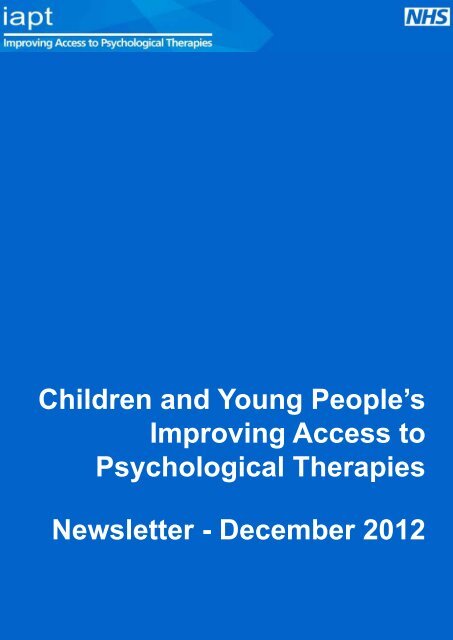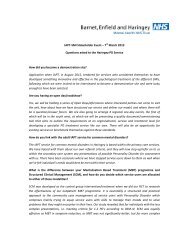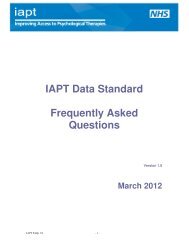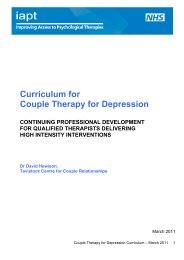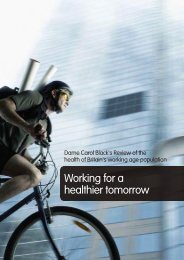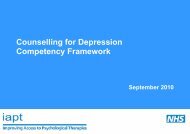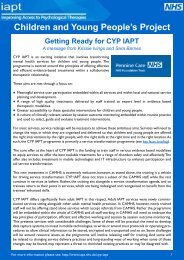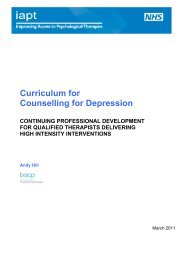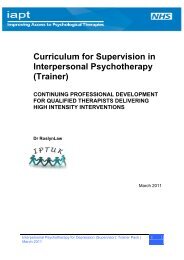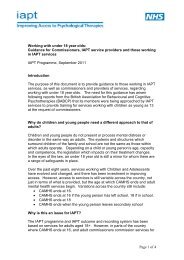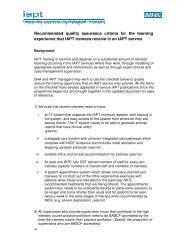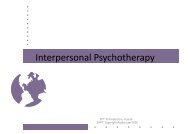December 2012 - IAPT
December 2012 - IAPT
December 2012 - IAPT
- No tags were found...
Create successful ePaper yourself
Turn your PDF publications into a flip-book with our unique Google optimized e-Paper software.
Children and Young People’s ProjectChildren and Young People’sImproving Access toPsychological TherapiesNewsletter - <strong>December</strong> <strong>2012</strong>For more information please see: http://www.iapt.nhs.uk/cyp-iapt1
Children and Young People’s ProjectWelcome and IntroductionWelcome to the <strong>December</strong> edition of the CYP <strong>IAPT</strong> newsletter. It has once againbeen an incredibly busy few months for everyone involved!Back in July we announced that the North-East and South-West collaborativeswould be joining CYP <strong>IAPT</strong>. These two teams have been working extremely hardand effectively to get courses developed and approved, trainees recruited and ITsystems ready for Routine Outcomes Monitoring (ROM). You can find articleson the South-West and North-East’s experiences of applying to CYP <strong>IAPT</strong> andestablishing a collaborative on pages 5 and 8. Over the past few months, year 1collaboratives have reflected on the lessons they learned and shared this wisdomwith curriculum groups and their new colleagues. Updates from Reading and Londoncan be found on pages 6 and 7. Salford has been running ROM workshops, andon pages 9 and 10 we have feedback and an overview of this training.Professor Peter FonagyNational Clinical Leadfor Children and YoungPeople’s <strong>IAPT</strong>Congratulations to all the trainees, supervisors and service leads who have completedtheir training – we know how hard you have worked, not just on the academic side but also toovercome practical issues as they arose in this first experimental year. We are enormously grateful for allyour feedback. It has been invaluable in improving the courses and overall experience for year 2. We areplanning a joint workshop in London at 1 pm on Friday 8th February 2013 for all those who attended theservice leads course in years 1 and 2 – please save the date in your diaries, further information will follow.Participation is at the heart of the CYP <strong>IAPT</strong> project, and the Greater Involvement, Future Thinking (GIFT)consortium, led by Yvonne Anderson, has been appointed to lead on this until 2015. Each collaborativehas been assigned a contact in the GIFT team and bespoke solutions tailored to local needs are beingdeveloped. You can find further details about this on page 3. We would like to thank Sarah Brennan andher team at YoungMinds for the invaluable contribution they made to the first year of the programme. Onpage 4 you can find an exciting article about innovative methods of self-referral to guide our thinking inrelation to CYP <strong>IAPT</strong>.A major intellectual, clinical and organisational challenge is integrating the new modalities, InterpersonalTherapy (IPT) and Systemic Family Therapy (SFT). Work is well underway and we hope to have draftcurricula ready by the New Year. All this has been happening against a background of trying to improveon and expand the existing provision in line with our learnings from the first year.As of 1st <strong>December</strong>, all of our year 1 sites have moved to full ROM. Using ROM to enhance your therapeuticrelationships and collaborative practice with the children, young people and families we serve is centralto CYP <strong>IAPT</strong>. No one is in any doubt that this presents challenges to you and your services, but every timewe meet with young people they tell us that being able to see and understand how things are going is notjust helpful but demonstrates concretely our commitment to consider them as a full partner in a jointeffort, rather than a passive recipient of treatment.As ever, we hope the newsletter will not only inform those who are already part of CYP <strong>IAPT</strong>, or hoping tojoin, but also encourage you to get in touch with your ideas and questions. You can find contact informationon page 10. Have a wonderful break.For more information please see: http://www.iapt.nhs.uk/cyp-iapt1
Children and Young People’s ProjectNew Team MembersWe are pleased to introduce two new members of staff who joined the project over the summer.Anne O’Herlihy, Extended Scope Project LeadI am delighted to be working with the CYP <strong>IAPT</strong> team to support CAMHSand their partners’ delivery of high-quality care for children, young peopleand parents/carers.Prior to this post, I worked at the Royal College of Psychiatrists Centrefor Quality Improvement (CCQI), where I managed a number of CAMHShealth service research projects (NICAPS, 2001; CIRS, 2007; COSI-CAPS,2007) and quality improvement and accreditation programmes. Duringmy time at CCQI, I helped to establish the Quality Network for InpatientCAMHS (2001-2003). More recently, I managed (with professionalsand stakeholders) the development of service standards for the safe andappropriate care of young people on adult wards (2009), a crisis and/orintensive response within community CAMHS for the Quality Networkfor Community CAMHS (2010), and practice standards for young peoplewith substance misuse problems (2011).My primary role within CYP <strong>IAPT</strong> is to support the extended scope of the project, to develop and offertwo further curriculum courses: interpersonal psychotherapy (IPT) for adolescents and systemic familytherapy (SFT), and all other aspects of the programme with the CYP <strong>IAPT</strong> team.Adriana Greco, Project Support OfficerSince July <strong>2012</strong> I have been working with Kathryn Pugh, the CYP <strong>IAPT</strong>Programme lead, and Anne O’Herlihy, the new project lead, to provideadministrative and assistance to workstreams within the CYP <strong>IAPT</strong> programme,ensuring a high standard of support to leads and managers,meetings and events.I previously worked in the pharmaceutical sector as Clinical Trials Associatefor Cancer Research UK and at CeNeS Pharmaceuticals plc (a biotechsponsor drug company in Cambridge) providing project support fora number of clinical research studies, in particular on early Phase I and IItrials involving diagnostic research. During my time at CeNes PharmaceuticalsI worked within the Clinical Development team which develops newtherapies for chronic pain and neurological disorders.For more information please see: http://www.iapt.nhs.uk/cyp-iapt2
Children and Young People’s ProjectGIFT – New Participation LeadWe are a partnership between Cernis and Associate DevelopmentSolutions (ADS) – a core team of five people with a long, combinedhistory of working in CAMHS, locally, regionally and nationally. Weare well known as leaders of transformation in CAMHS and hold apassionate belief in the importance of positive change and renewalin CAMHS. The participation of children and young people is integralto how we work. In addition to the core team, GIFT has a range ofpartners, young associates and volunteers.Yvonne Fiona JoeCathyJaneWe are working with a range of professional partners including Youth Access, the National Youth AdvocacyService, Practical Participation, Right Here and Mellow.GIFT will also be working directly with young people (we are recruiting now) to ensure that they are ableto influence the national CYP <strong>IAPT</strong> programme.Participation is a key strand across the whole of the CYP <strong>IAPT</strong> service delivery model, and the GIFTPartnership will ensure that young people are involved in the design, delivery and evaluation of the approachthat we take. We will ensure an innovative, creative and robust approach to working in partnership withyoung people: we use a youth work model that focuses on developing participation to the level whereyoung people will be the drivers of change and will make key decisions about their wellbeing and their services,supported by the adults around them. The model will enable children and young people to developtheir skills and give them support to increase their potential and to access wider life opportunities.Find out how MyAPT can help you embed participation in your CYP <strong>IAPT</strong> serviceMyAPT (www.myapt.org.uk) is a membership site that helps young people, mental health professionals,CAMHS partnerships and the universities that train them to embed children and young people’s participationin the way psychological therapies are delivered. It also has relevance for non-CYP <strong>IAPT</strong> sites andrelated professionals who want to embed participation.The benefitsBy using this site in conjunction with tailored support from the GIFT Partnership you will:• Feel more confident about how to involve young people, or be involved as a young person;• Have more skills and strategies for enabling user participation;• Experience an easier journey to embedding participation as a valued part of your everyday practice;• Improve young people’s satisfaction with your services.For more information please see: http://www.iapt.nhs.uk/cyp-iapt3
Children and Young People’s ProjectImproving Access: Self-ReferralThe South London and Maudsley NHS Foundation Trust (SLAM) has been implementing self-referral toCAMHS, both through the normal systems, and also through drop in services and self-referral groups. Here,Paul Calaminus, the Service Director, focuses on one such approach and sets out the challenges and successes.“Self-referral”: The ability of a parent or child to refer themselves into theCAMHS service without needing a professional referral to access serviceThe CAMHS Discover workshops offer manualised treatment for teenagers with anxiety and depression.They are run in schools, sports centres, youth clubs and community centres and we have seen around 70young people so far. We have put significant effort into consulting young people about self-referral andpublicity/signposting, working with the Teenager Advisor Group. The majority of young people we haveworked with have been supportive of the idea of self-referral, and we have designed specific publicitymaterial which has been spread across the local area through a website, Facebook, the radio and flyers.We have also visited schools and youth clubs to talk to young people about the service. Programmes aregiven titles such as “How to manage stress” and “How to keep it together in an imperfect world” in anattempt to make the process less stigmatising and more accessible.We have also added an option of “semi self-referral” where we give groups of young people (particularlyclasses in schools) information about the workshop programme and its benefits and then encourage youngpeople who are “stressed” to attend an information meeting with us. They can then decide if they wantto attend the workshops. This is time-consuming for the team and schools, but it does build a partnershipwith staff and helps young people to come forward to access the service. This is particularly importantbecause, overall, we believe that teenagers in particular seem less likely than adults to independently seekpsychological help/therapy due to a combination of developmental reasons (e.g., not able to take action toresolve problems), practical reasons (e.g., travel) and stigma. Importantly, this route remains a self-referralone – it is not necessary for the young person to be referred by anyone else.Overall, feedback from the young people about the process of self-referring has been positive, as has theirfeedback about the impact of the intervention (which is CBT-based) and the clinical outcomes achieved.For all young people we have been clear that the service is provided by SLAM and that professional clinicalstaff are involved. As part of initial conversations with young people, and within the group, we have emphasisedissues of confidentiality and addressed perceived risks of stigmatisation and bullying.As with other drop in and self-referral projects, record-keeping has been a governance issue. In addressingissues of stigma, we have kept records separate from those of the main Trust electronic patient record,unless a young person has needed onward referral to other Trust services. Across all drop-in services runwithin CAMHS, whether these are GP, street or community based, we have found this to be a necessaryprecondition to effectively engaging with young people and addressing issues of stigma. We have, of course,kept appropriate clinical records.In summary, the provision of self-referral routes has been effective in engaging some young people, withpositive impacts on their mental health and their experience of using CAMHS services. Self-referral initiativeshave also proved an effective way of providing a more community based service in alternative settings.For more information please see: http://www.iapt.nhs.uk/cyp-iapt4
Children and Young People’s ProjectUpdate from the South-WestCatherine Gallop and Ian Frampton from the South-West collaborative describe their experiences of biddingto join the CYP <strong>IAPT</strong> programme, and how all the stakeholders in the new collaborative have come togetheraround their shared values.Exeter UniversityDevon, Plymouth, Torbay CAMHS, Exeter Universityand Young Devon have joined to create a new South-West <strong>IAPT</strong> collaborative. We are a diverse groupof practitioners, managers, commissioners, trainingproviders and youth participation specialists who allhave a passion for working with young people andtheir communities. Providing a service across a largelyrural and coastal county, but with three major urbancentres, requires understanding of the service pressuresacross different geographic and demographicareas, which range from high deprivation to relativeaffluence.When shared passions come together there is potential for great creativity, butalso for conflict unless shared aspirations can be agreed. This was never moreevident than when considering our own values in the light of the values and visionof the CYP <strong>IAPT</strong> programme, and having to agree a common way forward.Our self-assessments gave us a good basis from which to put together our bid. Itwas important for each of us to appraise honestly our services and educationalprovision in the light of what CYP <strong>IAPT</strong> would be asking of us. In addition toour core values, we each needed to acknowledge our weaknesses and emphasisethe strengths each service would bring to the collaborative. And, althoughenormously diverse, the partners are complementary, and are learning how to collaborateacross organisational boundaries.At the heart of putting together a successful bid was high-level endorsement,not least the strong contribution from our children’s commissioner, as well astrusting, open and honest relationships across the leadership group. Althoughthe memory of the final presentations is a blur of huddles, late-night telephoneconversations, last-minute dashes across London, and fleeting encounters withother CAMHS teams in the foyer, one thing was clear and heartening: everyone inthis group went the extra mile to make the bid happen.Catherine Gallop,Programme LeadIan FramptonParenting LeadSo what would be our advice to others preparing to join CYP <strong>IAPT</strong>? Well, start with an honest self-appraisalof your own services, develop strong, open relationships with your partners, ensure you have endorsementat all levels from service users to commissioners, be prepared to go the extra mile, and don’t panic if yourPowerPoint lets you down on the day!For more information please see: http://www.iapt.nhs.uk/cyp-iapt5
Children and Young People’s ProjectUpdate from ReadingIt is an exciting time for Reading, as year 1 trainees are returning to their workplaces to embed their learningfor the benefit of children, young people and parents. 19 CBT trainees, six parenting trainees, sevensupervisors and 18 leadership delegates hope to graduate in the Summer of 2013.We gained new partners for Year 2 back in July this year: Berkshire Healthcare NHS Foundation Trust,South Essex Partnership NHS Foundation Trust, and Central and North West London NHS FoundationTrust. We have also been fortunate to be joined again by our year 1 partners: 2Gether Trust, Gloucester,and Bournemouth and Poole Children and Young People’s Emotional Health and Wellbeing Service, andDorset Healthcare University NHS Foundation Trust. We are looking forward to working with partnersold and new and sharing the lessons learned from year 1.We were busy with interviews during the summer and have recruited 35 new trainees, eight supervisorsand 22 service leads for year 2. The leadership and supervisors’ courses started in November and thetrainees all start at the University of Reading in <strong>December</strong>.We have been changing the way we record information and will soon be moving to a new system whichwill give us remote access and will provide clinical staff with instant feedback about how the children andyoung people are getting on. We have also been trialling the use of iPads and hope this latest technologywill help us collect information about how the training is affecting the young people we look after.As part of the leadership programme, year 1 graduates are working on projects around self-referral andimplementation of routine outcome measures across whole services. They are also currently working onpilots to ensure lessons learned in Year 1 are taken into account prior to full implementation. In addition,Year 1 leadership graduates will also be coaching Year 2 leadership delegates.Our young people been creating two films to raise awareness ofCYP <strong>IAPT</strong>. A group of around 20 initially met with a productioncompany in May and since then have been producing two films, oneaimed at younger children and another aimed at adults. The youngpeople have worked extremely hard to storyboard the films, draw thegraphics, record the voiceovers and film footage. They have learnedmany new skills and have worked brilliantly as a team. The penultimateversions of the films were premiered at the University of Reading’send of year 1 celebration event on 5th <strong>December</strong> and the young peopleare looking forward to getting together for the “wrap party”. Thefilms will be made available for all to view early in the New Year.Young people from Reading areproducing two films“What amazed me was how much we’ve done and that from ourideas to start with, we now have something people can watch.I can’t wait to see my name at the end!”Young participantFor more information please see: http://www.iapt.nhs.uk/cyp-iapt6
Children and Young People’s ProjectUpdate from LondonThe past few months have involvedconsiderable change within the collaborative,most significantly, an expansionto 16 partnerships, which include 20CAMHS services, 11 local authoritiesand 13 voluntary sector organisations.Geographically speaking, the collaborativereaches from Cambridge and Hertfordshirein the north to West Sussexin the south, with 14 London boroughsin between. This is in addition to thecoordination needed between two universities!Coordinating this extensiveMap of the London collaborative and partnershipsnetwork of services is a daunting task, but we are developing increasing knowledge and expertise aboutwhat structures we need to make this work, and also strengthening relationships between the partnershipsand universities. This is all coordinated and supported by a full-time project manager. Additionally we areworking closely with London Strategic Health Authority (SHA) in thinking about how to support non-CYP<strong>IAPT</strong> CAMHS services in preparing for applications next year and/or developing their services in line with<strong>IAPT</strong> principles. The second-year partnerships have almost completed appointing new members of staff asbackfill for trainees.This expansion has meant a significant enlargement of the Steering Group, which has been reconfiguredfor collaborative problem-solving of specific contemporaneous questions, the biggest of which ishow to implement systems for collecting data from service user feedback and outcome measurementtools which increase efficiency, effectiveness and mobility and bring the 90% target into range. A closesecond is working up a widely feasible solution to the problems faced by partnerships in supportingtheir trainees to bring clinical session video footage to training sessions; we have been working closelywith Meganexus to address this since the summer in anticipation of the second year of therapy traineesstarting in January.We are particularly proud of the developed content and structure of our courses, delivered to the partnershipsjointly by University College London and the Anna Freud Centre, and King’s College London. This isbeing achieved through consultation with students in year 1, our colleagues in collaboratives around thecountry via the centrally coordinated curriculum groups, and based upon our experiences in this first year,which will soon deliver the first trained cohort of therapists. Taking up the opportunities offered by thecentral team to expand training provision, existing expertise within the partnerships is being drawn on todevelop the teaching groups and bring a greater richness of clinical and management experience alongsidethe practical approach of implementation science to provide greater support to service leaders on site.This has included recruiting tutors for the manager course from first-wave partnerships.For more information please see: http://www.iapt.nhs.uk/cyp-iapt7
Children and Young People’s ProjectUpdate from the North-EastWe consist of Northumbria University Faculty of Health and Life Sciences, Rotherham, Doncaster andSouth Humber NHS Foundation Trust (RDASH) and Tees, Esk and Wear Valleys NHS Foundation Trust(TEWV).Applying for and then preparing to be a site for CYP <strong>IAPT</strong> has been hectic at times, but has also been anenlightening and empowering journey for our organisations, from initial construction of the bid (March<strong>2012</strong>), to university validation of academic programmes (November <strong>2012</strong>).Universities often involve stakeholders when planning professional development for practitioners, butNorthumbria has achieved a much deeper level of engagement when applying for CYP <strong>IAPT</strong> and planningcourses. CYP <strong>IAPT</strong>’s “whole systems transformational” approach contrasts with the usual process of servicesseconding students to courses. It is often assumed that after completing training courses studentsreturn to practice with developed skills, and service improvement logically follows. Whilst this may betrue, the service transformation agenda embedded within CYP <strong>IAPT</strong> makes sure that improvement is anexplicit rather than an implicit assumption.Collaborating trusts have been working closely with university providers. Workforce and staff developmentare important issues for effective service transformation. The CYP <strong>IAPT</strong> approach has led to a moresystematic consideration of workforce development. Supervisors and service leads have already beguntraining and the main programme is due to start in January 2013, with participants looking forward to theirtraining – whilst, of course, being slightly apprehensive about the journey ahead. The collaboration betweenorganisations will not cease once planning is complete, but is integral to the main academic programme.Trust partners have gained a useful insight into the processes involved in operationalising an academicprogramme from conceptual curriculum to tangible delivery. At the validation event we were praised forour collaborative approach to development.Young people were actively involved in the recruitment of students and this input has been a delight forthe university and both partner trusts. For us this experience underscored the importance of ensuringparticipation throughout planning and implementation.The national project team has been a tremendous source of support, and existing collaboratives havekindly shared their experiences and ideas. The process has not been without hitches, but strong relationshipshave been forged between three like-minded organisations that are future-facing and embracetransformational change in the pursuit of high-quality services. This has resulted in clear mutual expectationsduring the application and project initiation stages, laying a firm foundation for collective problemsolvingas we move to implementation.For more information please see: http://www.iapt.nhs.uk/cyp-iapt8
Children and Young People’s ProjectROM Workshops in SalfordRoutine Outcomes Monitoring (ROM) is a key element of the successful implementation of CYP <strong>IAPT</strong>.Salford collaborative therefore decided, with the support of NHS North West, to run a series of workshopson ROM for all partnerships to raise awareness and support implementation.The workshops had 5 aims: 1) to raise awareness of the key elements of CYP <strong>IAPT</strong>; 2) to ensure a baselineknowledge of CYP <strong>IAPT</strong> across the workforce; 3) to introduce and increase awareness of nationallyagreed CYP <strong>IAPT</strong> measures; 4) to provide an opportunity to experience and test application in practice;and 5) to identify relevant internal and external networks and the necessary resources for successfulimplementation.The one-day workshops were delivered to a total 152 staff members. The majority were attended by asenior manager, which ensured visible strategic ownership and commitment to the successful implementationof CYP <strong>IAPT</strong>. In several cases data managers attended, providing up to date information on theprogress of the organisations’ IT resources and infrastructure. They were also able to provide insights intothe challenges and potential local solutions with regard to data collection, input and analysis.After the workshops, a survey was distributed and an analysis of participants’ responses showed that morethan 90% found the training very useful (see below):Completed questionnaires Positive (%) Neutral (%) Negative (%)Q1 Awareness of CYP <strong>IAPT</strong> transformation and itsaims (Aims 1 & 5)91 9 0Q2 Awareness CYP <strong>IAPT</strong> Routine OutcomeMeasures (Aims 2, 3 & 5)93 7 0Q3 (Activity 1) Using practitioner forms, SDQ,RCADS, clinical bands (Aim 4)94 4 1Q4 Awareness of goal-based outcomes(Aims 2, 3 & 5)94 5 1Q5 (Activity 2) Using GBOs ORS, SRS (Aim 4) 95 3 2Five key themes emerged from the survey:1) Content: those attending recognised and commented upon the amount of information that needed tobe presented, and did not realise the range of outcome measures being considered for use.2) Information technology: there were significant concerns about services’ IT capacity and the lack ofaccess to suitable hardware. IT infrastructure was seen as a major factor affecting the services’ ability tocarry out ROM.3) Effective communication: the majority of those attending the workshops were aware of CYP <strong>IAPT</strong> andwelcomed the information provided, acknowledging the value of the key principles of CYP <strong>IAPT</strong>.For more information please see: http://www.iapt.nhs.uk/cyp-iapt9
Children and Young People’s Project4) Infrastructure: The ability of the current CAMHS infrastructure to support the implementation of ROMand CYP <strong>IAPT</strong> generally was a regular subject of discussion. Concerns were raised in particular about howto include ROMs live in session due to increased service level pressures and expectations.5). Moving forward: a key theme in all of the workshops delivered was a willingness of the workforce tosupport the implementation of the key elements of CYP <strong>IAPT</strong>, recognising that many of the deliverableswere, in fact, markers of an effective CAMHS.In summary, ROM requires a cultural shift for many organisations and requires a high level of supportfor successful implementation. We have found a significant degree of enthusiasm for the use of ROM inpractice. Ensuring effective communication to the entire workforce is one of the most challenging aspectsof CYP <strong>IAPT</strong>. The project is complex and ambitious, and its continued successful implementation will to agreat degree depend upon the goodwill of the committed workforce.AcknowledgementsWe would like to acknowledge the support of all the partnerships within the Manchester LearningCollaborative and thank all those who attended the workshops for the valuable contributions made.Coming soon• Special edition: a newsletter dedicated to outcomes and evaluation is coming out in January.• Save the date: we are hosting a joint workshop for all those who attended the service leads course inyear 1 and 2 in London at 1 pm on Friday 8th February 2013. Further details to follow.Contact Us and Our YouTube ChannelThe CYP <strong>IAPT</strong> YouTube channel is up and running. Youcan watch the presentations from the July conference andsome videos on participation by clicking this link.If you have any interesting videos relating to the projectthat you would like to share, please email Rose Palmer(rose.palmer@ucl.ac.uk) with details.Please also contact Rose if you have any suggestions forarticles or comments about the newsletter.For more information please see: http://www.iapt.nhs.uk/cyp-iapt10


